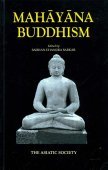Dashabhumi, Daśabhūmi, Dasha-bhumi: 7 definitions
Introduction:
Dashabhumi means something in Buddhism, Pali, Hinduism, Sanskrit. If you want to know the exact meaning, history, etymology or English translation of this term then check out the descriptions on this page. Add your comment or reference to a book if you want to contribute to this summary article.
The Sanskrit term Daśabhūmi can be transliterated into English as Dasabhumi or Dashabhumi, using the IAST transliteration scheme (?).
In Buddhism
Mahayana (major branch of Buddhism)
Source: Wisdom Library: Maha Prajnaparamita SastraDaśabhūmi (दशभूमि) means the “Ten Bodhisattva Grounds or Abodes”;
Ten bodhisattvabhūmis, named and explained, according to the Mahāvastu referring to a Daśabhūmikasūtra. The names of the ten bhūmis are indicated in the Mahāvastu,
- Durārohā, bhūmi difficult of access.
- Baddhamānā, hindered bhūmi.
- Puṣpamaṇḍitā, bhūmi adorned with flowers.
- Rucrā, delightful bhūmi.
- Cittavistarā, stretching the mind bhūmi.
- Rūpavatī, bhūmi full of beauty.
- Durjayā, invincible bhūmi.
- Janmanideśa, confirmation of birth (?).
- Yauvarājya, quality of the crown prince.
- Abhiṣeka, crucial anointment.
The Mahāvastu is alone in proposing this classification of which scholastic Buddhism has no account.
Source: academia.edu: A Study and Translation of the GaganagañjaparipṛcchāDaśabhūmi (दशभूमि) refers to the “ten stages”, according to the Gaganagañjaparipṛcchā: the eighth chapter of the Mahāsaṃnipāta (a collection of Mahāyāna Buddhist Sūtras).—Accordingly, “How then, son of good family, does the Bodhisattva appear to many beings performing the deeds of a Buddha (buddhakārya) even when the Buddhas do not appear? Son of good family, [...] (7) he has perfected the purification of the ornaments of body, speech, thought, the auspicious marks and signs by accumulating all collections of merits; (8) he has perfected the purification of the ten stages (daśabhūmi) by obtaining the stage of consecration; (9) he has perfected the purification of all qualities of the Buddha by accumulating the collection of knowledges”.
Source: Brill: Śaivism and the Tantric Traditions (mahayana)Daśabhūmi (दशभूमि) refers to one of the Navadharma (“collection of nine texts”) employed for ritualistic practices in Kathmandu Valley, in the era of Mahindra Vira Vikram Shah (r. 1955–1972).—Cf. Tuladhar–Douglas 2006, 144–147 and von Rospatt 2015, 819–821. The latter remarks that “these canonical works are not so much studied for their content as liturgically recited or put to other ritual uses”.

Mahayana (महायान, mahāyāna) is a major branch of Buddhism focusing on the path of a Bodhisattva (spiritual aspirants/ enlightened beings). Extant literature is vast and primarely composed in the Sanskrit language. There are many sūtras of which some of the earliest are the various Prajñāpāramitā sūtras.
Tibetan Buddhism (Vajrayana or tantric Buddhism)
Source: Brill: Śaivism and the Tantric Traditions (tantric Buddhism)Daśabhūmi (दशभूमि) refers to the “ten Bodhisattva stages”, according to the Nāmamantrārthāvalokinī by Vilāsavajra, which is a commentary on the Nāmasaṃgīti.—Accordingly, [while describing Mañjuśrī]—“He is [described in NS 10 as] the jñānasattva since he dwells in the heart of all the tathāgatas. The jñānasattva Mañjuśrī is not the bodhisattva that is the master of the ten [bodhisattva] stages (daśabhūmi-īśvara). Rather, he is non-dual gnosis, the perfection of wisdom itself”.

Tibetan Buddhism includes schools such as Nyingma, Kadampa, Kagyu and Gelug. Their primary canon of literature is divided in two broad categories: The Kangyur, which consists of Buddha’s words, and the Tengyur, which includes commentaries from various sources. Esotericism and tantra techniques (vajrayāna) are collected indepently.
General definition (in Buddhism)
Source: Buddhist Door: GlossaryAccording to the Mahāvastu, the ten stages are:
- difficult to enter, (Durārohā),
- fastening (Baddhamānā),
- adorned with flowers (Puṣpamaṇḍitā),
- beautiful (Rucirā),
- expansion of the heart (Cittavistarā),
- lovely (Rūpavatī),
- difficult to conquer (Durjayā),
- ascertainment of birth (Janmanideśa),
- installation as crown prince (Yauvarājya)
- and coronation (Abhiṣeka).
Languages of India and abroad
Sanskrit dictionary
Source: Cologne Digital Sanskrit Dictionaries: Monier-Williams Sanskrit-English DictionaryDaśabhūmi (दशभूमि):—[=daśa-bhūmi] [from daśa] m. Name of a, [Buddhist literature] Sūtra
[Sanskrit to German]
Sanskrit, also spelled संस्कृतम् (saṃskṛtam), is an ancient language of India commonly seen as the grandmother of the Indo-European language family (even English!). Closely allied with Prakrit and Pali, Sanskrit is more exhaustive in both grammar and terms and has the most extensive collection of literature in the world, greatly surpassing its sister-languages Greek and Latin.
See also (Relevant definitions)
Partial matches: Dasa, Bhumi, Taca.
Starts with: Dashabhumiga, Dashabhumika, Dashabhumikasutra, Dashabhumisha, Dashabhumishvara, Dashabhumisutra.
Ends with: Dvadashabhumi.
Full-text: Dashabhumiga, Dashabhumishvara, Dashabhumisha, Dasa, Navadharma, Sadharanabhumi.
Relevant text
Search found 8 books and stories containing Dashabhumi, Daśabhūmi, Dasha-bhumi, Daśa-bhūmi, Dasabhumi, Dasa-bhumi; (plurals include: Dashabhumis, Daśabhūmis, bhumis, bhūmis, Dasabhumis). You can also click to the full overview containing English textual excerpts. Below are direct links for the most relevant articles:
Chaitanya Bhagavata (by Bhumipati Dāsa)
Verse 3.2.371-372 < [Chapter 2 - Description of the Lord’s Travel Through Bhuvaneśvara and Other Placesto Jagannātha Purī]
Manasara (English translation) (by Prasanna Kumar Acharya)
Maha Prajnaparamita Sastra (by Gelongma Karma Migme Chödrön)
II. The three faculties of understanding according to the Mahāyāna < [Part 3 - The three faculties of understanding]
Note (2). The ten Bodhisattva grounds or abodes < [Chapter XX - (2nd series): Setting out on the Mahāyāna]
Part 1 - Definitions of Prajñāpāramitā < [Chapter XVII - The Virtue of Generosity]
Buddhist records of the Western world (Xuanzang) (by Samuel Beal)
Chapter 2 - Country of ’O-yu-t’o (Ayodhya) < [Book V - Six Countries]
Sutra of Ksitigarbha Bodhisattva's Fundamental Vows
The Great Buddhist Emperors of Asia (by Shibani Dutta)
Related products
